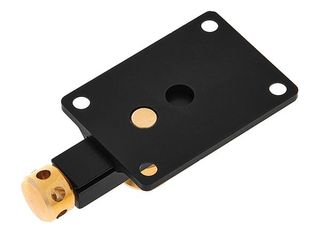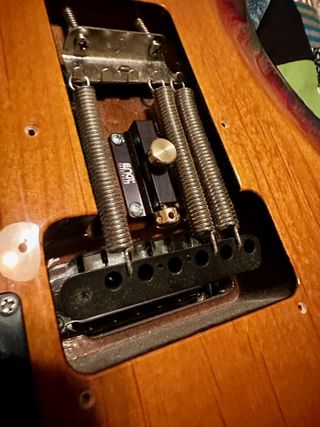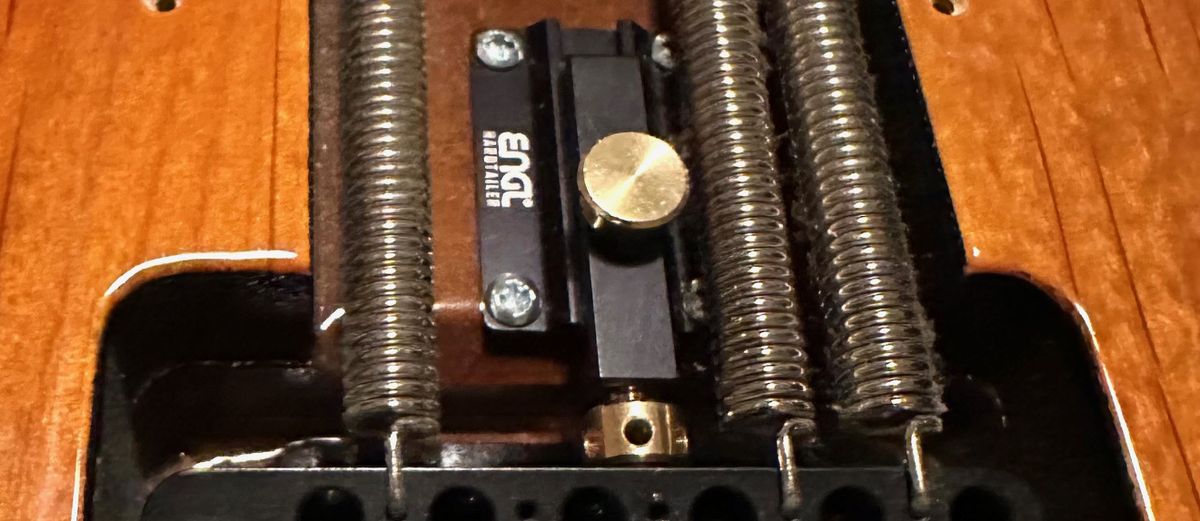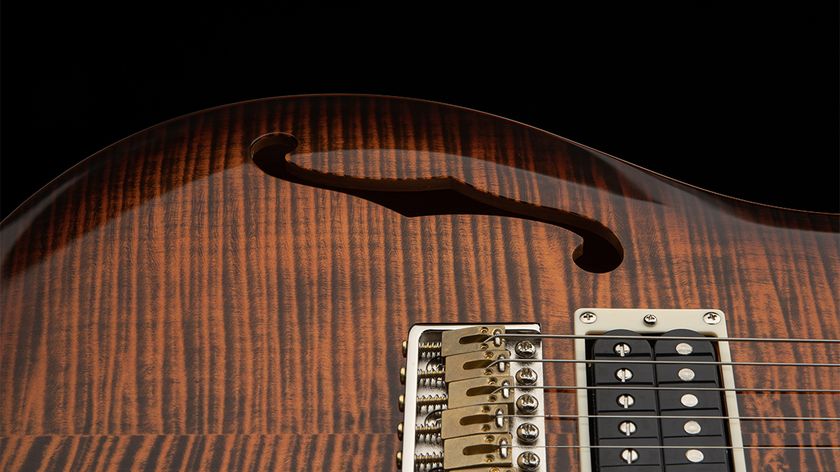GuitarPlayer Verdict
Engl's tiny contraption converts a tremolo from floating to dive-only in a matter of seconds (and vice versa), allowing you to change tuning or strings without throwing the other strings out of tune. While it's a bit expensive and requires that you drill four small holes in the spring cavity and keep the backplate off your guitar, the Hardtailer is well engineered, solidly built and feather-light.
Pros
- +
Bonehead simple to operate
- +
Tiny, with a rock-solid build
- +
Zero involvement with your guitar when not in use
- +
It works!
Cons
- -
Requires drilling four small screw holes in spring cavity
- -
Necessitates living without a backplate on your guitar
- -
A bit spendy
You can trust Guitar Player.
If you love playing with a floating bridge but hate the fact that when you detune or break a string with this setup the other strings pull horrendously out of tune, well, Engl may have a worthy solution for you — the Engl Hardtailer.
First, for the uninitiated, the advantages of a floating bridge — a tremolo bridge set so that the vibrato bar can both lower and raise strings in pitch — are many.
For one, a floating setup allows you to use the bar to apply tasteful vibrato that encircles notes from above and below, pitch-wise — the way a great singer or slide guitarist might —thus achieving that highly sought after “vocal” vibrato sound. (Non-floating tremolo bridges are dive-only, and can only lower notes.)
Secondly, for wilder moments, a floating bridge allows for not only divebomb sounds and, depending on your spring setup, trem “warbles,” but also reverse dives — we’re talking about those soaring melodic ascents in pitch you hear on such mesmerizing Stratocaster performances as Jeff Beck’s “Where Were You,” or Brad Gillis’s “Sister Christian” solo.
Finally, if the apocalyptic divebomb you just put your strings through seemed to leave your electric guitar slightly out of tune because one or more strings got a little bit caught in the nut on the way back up (a non-issue for locking-nut players), well, if you’re an experienced bar jockey, you know that a bonus feature of a floating bridge is that if you give the bar a small upward tug, it may pull strings pretty much perfectly back in tune.
As mentioned earlier, though, the most common problem you’ll face as a “floating” player is when you’re on the gig and want to switch to a tuning like dropped-D. This task is time consuming, because each time you change the tension on one string (i.e., twist its tuning peg), it also changes the other strings’ tensions, putting them out of tune. By the time you finish tuning the last string, you discover the previous five you just tuned are now out of tune again, and you have to start the process over … and over. You may find this task so tedious that you decide it’s easier to haul around to gigs a second guitar that’s already in the alternate tuning, rather than attempt a new tuning in the short time you have between songs.

Enter the Engl Hardtailer, which marks Engl’s first foray away from amplifiers and related gear and into guitar accessories. There have been several bridge-stabilizing devices over the years but you’ll be hard-pressed to find one more stable, compact, and bonehead simple to use than the Hardtailer.
Made in Germany and taking up no more real estate two standard guitar picks, the Hardtailer is easy to install and works on most block-and-springs-based tremolo systems, such as those popularized by Fender, Ibanez, and Floyd Rose — provided that, like most players who use floating bridges, you don’t have all five springs installed.
Before you get started with installation, though, it’s crucial to make sure your guitar’s action and general setup are exactly how you like them to be. And if you don’t have that little cavity routed into the face of your guitar behind the bridge (a common locking-trem feature that allows for sky-high reverse dives), it’s crucial to set your bridge’s pitch ascent maximum to your preference before starting the job.
(Tip: Many players use the G string as a measure. Scott Henderson, for example, has been known to set his bridge so that when he pulls the bar all the way up, it raises the G a major third, while other players may choose their max to be a minor third or less.)

Now, with your bridge in resting position (that is, floating at “zero point”), you’re ready to install. Before you decide to put a Hardtailer on your pristine ’62 Stratocaster, though, know that the product is not entirely non-invasive — it requires the drilling of four tiny wood screws into the guitar’s back cavity beneath the springs. With a smidge of mechanical ability and understanding, it’s an easy job, but there’s no shame in having your tech do it. I had Los Angeles guitar tech Seth Mayer install my test unit on an Ernie Ball Music Man Cutlass during routine guitar maintenance.
Designed by longtime Engl user and Munich-based guitarist Martin Kronbichler, the Hardtailer is small and lightweight and features an aluminum base and shaft. When the device is adjusted correctly and you slide the shaft out to its active position, it satisfyingly snaps into place, immovable, with its brass adjustment wheel just kissing the trem block, but not pushing on it (which would cause the strings to go flat), thus preventing the springs from pulling the block even one micrometer in the headstock (sharp) direction.
To adjust the Hardtailer properly, make sure the guitar is in your “floating” tuning (which, for typical players, will be standard tuning) and have an electronic guitar tuner active. Now, with the bridge at zero point, use a tiny screwdriver shaft or the long end of a hex wrench to adjust the brass knob until it just touches the block as described above. (For details on how to do this most precisely, as well as installation instructions, visit the Hardtailer’s online manual on Engl’s website.)
Once you’ve got the Hardtailer set up nicely, it lives up to its promise — it allows you to detune one or more strings without the other strings going sharp. And even if you don’t detune, engaging it essentially turns your floating guitar into a (here comes that word again) hardtail, allowing to rest your palm on the bridge without pulling the strings sharp. Epic wins!
Engaging the Hardtailer is also useful for (locking trem users will love this) holding the bridge steady during string changes. Life hack!

And, last but not least, one of my favorite features of the Hardtailer is the simple fact that it, unlike some competing devices, does not attach to your block or spring claw, so when it is not engaged, it has zero involvement with your guitar. In other words, when the Hardtailer is not in use, you will never know it’s there.
To move the shaft between active or inactive positions, simply unlock it by pulling up on the spring-loaded brass locking pin, which may resemble one of those finger-tightening screws found on various pieces of guitar hardware, but most certainly is not one. Then, slide the shaft the appropriate direction until the locking pin again snaps into place.
You’ll find you get good at this little maneuver and can reach behind your guitar and do it without looking — which is extremely helpful if you’re in floating mode and break a string and need to instantly get your remaining strings back in tune so you can finish out the song.
Shredders rejoice: The Hardtailer doesn’t care what type of saddles you have up top, which means that yes: It also works just fine with locking trems, including those rigged with EVH D-Tuna or Tone Vise Pitch Shifter string-detuning attachments.
So far, with my G set so I can yank it up a minor third (three half-steps) when floating, the Hardtailer delivers on its promise perfectly. My only concern with it is that when it’s engaged (which means the guitar is now “dive only”) and I’m applying subtle bar vibrato, I find it’s more prone to make a small tapping sound than a conventional dive-only tremolo setup (like a Stratocaster bridge set to rest on the body) might when let go of the bar. This sound results from the guitar’s metal bridge block contacting the Hardtailer’s brass wheel — but I don’t care! I’m in Dropped-D on a bridge that was floating a second ago!

(Tip: If this anomaly bugs you, affixing a small piece of cloth Band-Aid or similar — the sticky part, of course! — on the block where it meets the wheel minimizes this sound, but may require you shortening the shaft’s reach a little via adjustment of the wheel. But if you’re doing divebombs and other more aggressive bar antics, the tapping sound shouldn’t be an issue.)
It's also worth knowing that the Hardtailer is not 100 percent “set it and forget it.” You will have to adjust it from time to time. Did you raise your action? Adjust your truss rod? Change spring tension? Get on a plane in arid Aspen and get off in humid Key West? If so, you may have to turn that brass wheel one direction or the other to get the Hardtailer to again deliver Dropped-D perfectly in tune.
There’s also the price. To some players, $87 retail may feel like a significant cash outlay for such a tiny contraption. For me, though, this is a small price pay for a huge win — a perfectly engineered, feather-light, super solid German-built piece of gear that lets me quickly get in and out of dropped D without switching guitars. I can now do fly dates with a floating trem — sweet!
SPECIFICATIONS
CONTACT engl-amps.com
PRICE $87
MATERIALS High grade brass and aluminum
BUILT Germany
KUDOS Bonehead simple to operate. Tiny. Rock solid. Zero involvement with your guitar when not in use. Works!
CONCERNS Requires drilling of four small screw holes in guitar body’s spring cavity. Necessitates living without a backplate on your guitar. A bit spendy.

Whether he’s interviewing great guitarists for Guitar Player magazine or on his respected podcast, No Guitar Is Safe – “The guitar show where guitar heroes plug in” – Jude Gold has been a passionate guitar journalist since 2001, when he became a full-time Guitar Player staff editor. In 2012, Jude became lead guitarist for iconic rock band Jefferson Starship, yet still has, in his role as Los Angeles Editor, continued to contribute regularly to all things Guitar Player.
Watch Jude play guitar here.
- Jude GoldLos Angeles Editor, Guitar Player

“A good example of how, as artists, you have to blindly move forward with crazy ideas”: The story of Joe Satriani’s showstopping Crystal Planet Ibanez JS prototype – which has just sold for $10,000

“I felt myself starting to cry.” Eric Clapton’s 'MTV Unplugged' Martin acoustic returns in two guises. But Slowhand’s affinity for the guitar brand began long before that seminal live performance

"Jaco thought he was gonna die that day in the control room of CBS! Tony was furious." John McLaughlin on Jaco Pastorius, Tony Williams, and the short and tumultuous reign of the Trio of Doom










